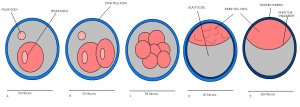2009 Group Project 4: Difference between revisions
| Line 72: | Line 72: | ||
<references /> | <references /> | ||
Dr Mark Hill 2009, UNSW Embryology ISBN: 978 0 7334 2609 4 - UNSW CRICOS Provider Code No. 00098G [http://embryology.med.unsw.edu.au/OtherEmb/mouse1.htm] | 1. Dr Mark Hill 2009, UNSW Embryology ISBN: 978 0 7334 2609 4 - UNSW CRICOS Provider Code No. 00098G [http://embryology.med.unsw.edu.au/OtherEmb/mouse1.htm] | ||
Bard, Kaufman, Dubreuil, Brune, Burger, Baldock, Davidson (1998). An internet accessible database of mouse development anatomy based on a systemic nomenclature, Mechanisms of development, (74) 111-120. | 2. Bard, Kaufman, Dubreuil, Brune, Burger, Baldock, Davidson (1998). An internet accessible database of mouse development anatomy based on a systemic nomenclature, Mechanisms of development, (74) 111-120. | ||
{{Template:Projects09}} | {{Template:Projects09}} | ||
Revision as of 20:39, 24 August 2009
MOUSE
Timeline of Development
Staging
Mouse embryonic development commences once the female's egg or oocyte has become fertilized by the male's sperm. Mouse development has a gestation period of 19-21 days, and can range in different strains of mice. The development of an embryo can be categorized into different stages including cell number, somite stages and morphology. The most common method of staging is by Theiler (1989) which categorizes mouse development into prenatal and postnatal stages consisting of 26 and 2 stages respectively.
| Theiler Stage | Embryonic Age in Days Post Coitum (dpc) | Stage Characteristic | Cell Characteristics | Zona Pellucida | Location | |
|---|---|---|---|---|---|---|
| 1 | 0-0.9
(range 0-0.25) |
One-celled embryo (fertilized) | One cell | Present | Ampulla | |
| 2 | 1
(range 1-2.5) |
Dividing egg | 2-4 cells
- 1st cleavage after 24hrs |
Present | Travelling down oviduct | |
| 3 | 2
(range 1-3.5) |
Morula (early to fully compacted) | 4-16 cells | Present | Oviduct. Usually near utero-tubal junction. | |
| 4 | 3
(range 2-4) |
Change from Morula to Blastocyst
-Intra-cellular matrix present -Blastocoelic cavity evident |
16-40 compacted cells
-Inner cell mass -Outer layer of trophectoderm cells |
Present | Uterine lumen | |
| 5 | 4
(range 3-5.5) |
Zona free Blastocyst (hatching) | Blastocyst is ready to implant as surrounding cell layer of zona pelludica is lost | Absent | Uterine lumen |
Dr Mark Hill 2009, UNSW Embryology ISBN: 978 0 7334 2609 4 - UNSW CRICOS Provider Code No. 00098G
Once the mouse blastocyst has implanted on the uterine wall, the embryo undergoes many changes in size and shape to form a cylindrical structure. Cell proliferation of embryonic ectoderm is activated and results in an increase in embryonic tissue volume. Along with this growth, is the growth of the inner cell mass and trophectoderm layer. The inner cell mass and trophectodermal cells proliferate into the space made by the blastocoel cavity to form a layer of epiblast cells and the pro-amniotic cavity. This results in two layers;
- the inner epiblast layer
- the outer visceral endoderm layer.
This stage or egg cylinder stage is evident of the well defined extra-embryonic and embryonic regions. The embryo can now be visualized with a dorsal and ventral surface. These two surfaces consist of the pro-amniotic cavity surface of epiblast cells on the dorsal surface and the outer layer of visceral endoderm cells on the ventral surface.
History of Model Use
Genetics
Current Embryology Research
References
1. Dr Mark Hill 2009, UNSW Embryology ISBN: 978 0 7334 2609 4 - UNSW CRICOS Provider Code No. 00098G [1]
2. Bard, Kaufman, Dubreuil, Brune, Burger, Baldock, Davidson (1998). An internet accessible database of mouse development anatomy based on a systemic nomenclature, Mechanisms of development, (74) 111-120.
ANAT2341 group projects
Project 1 - Rabbit | Project 2 - Fly | Project 3 - Zebrafish | Group Project 4 - Mouse | Project 5 - Frog | Students Page | Animal Development
